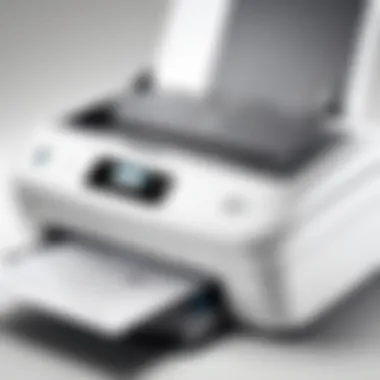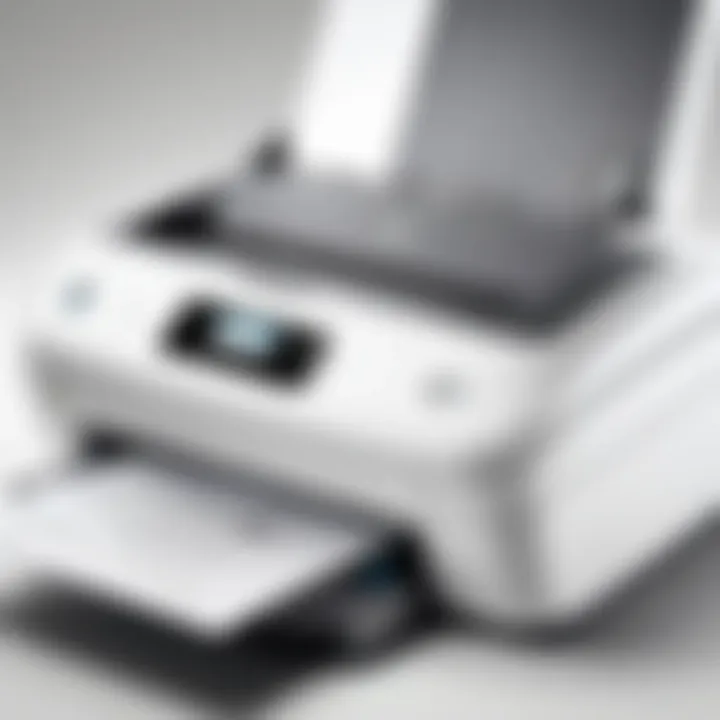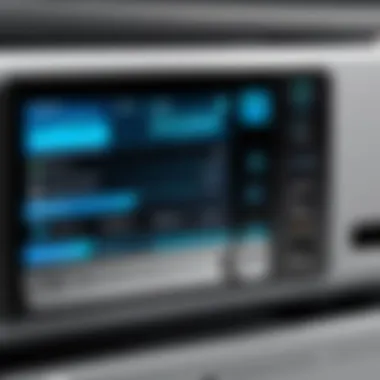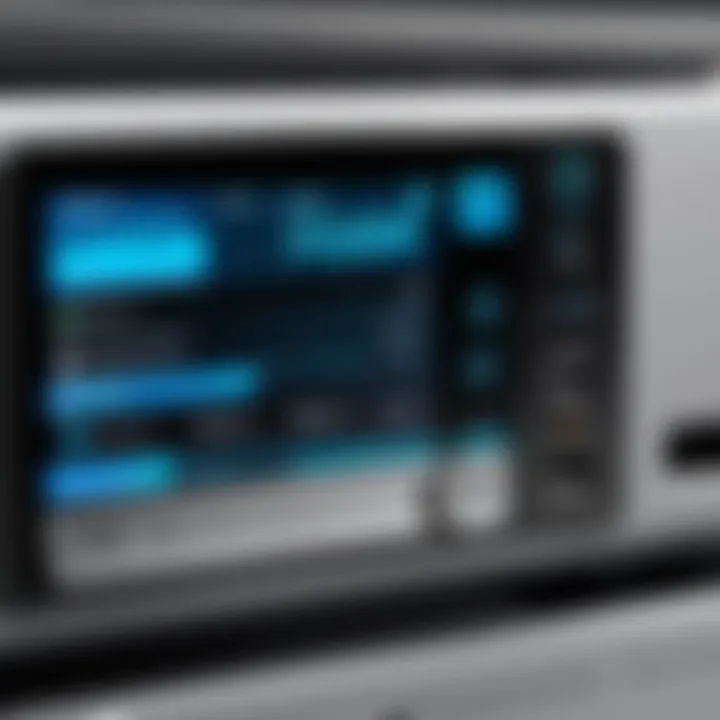Comprehensive Review of HP DeskJet Printers: Scanners & Copiers


Intro
The HP DeskJet line of printers is a popular choice among both individuals and professionals. This device goes beyond simple printing tasks. It offers multifunction capabilities, allowing it to serve as a scanner and copier. This feature enriches its utility in various settings, from traditional offices to home environments. This article will dissect the various aspects of HP DeskJet printers, focusing on their effectiveness in scanning and copying. By integrating technical specifications with user experiences, we aim to present a thorough understanding of these machines.
Understanding the features, advantages, and possible shortcomings of these printers is critical for making informed decisions. Attention will also be paid to maintenance, cost-effectiveness, and upcoming trends in printer technology, which are vital for IT professionals and tech enthusiasts alike.
Product Overview
The HP DeskJet series is distinguished for its sleek design and impressive multifunction capabilities. Key features that set these printers apart include the ability to scan documents, create copies, and connect wirelessly. These features are attractive for users looking for efficiency and space-saving solutions.
Key Features
- Multifunctionality: Besides printing, users can scan and copy documents with ease. This multifunctional aspect is especially beneficial for professionals.
- Wireless Connectivity: Built-in Wi-Fi allows for easy printing and scanning from various devices, including smartphones and tablets.
- Compact Design: These printers are designed to occupy minimal space while delivering full functionality.
- Mobile Printing Support: Compatibility with apps such as HP Smart enhances user convenience.
Technical Specifications
HP DeskJet printers come with various specifications depending on the model. Common features include:
- Print Resolution: Typically, up to 4800 x 1200 optimized dpi for color images.
- Scanning Resolution: Often around 1200 dpi for efficient scanning.
- Copy Speed: Generally ranges from 7 to 10 pages per minute for black-and-white documents.
- Input Tray Capacity: Usually holds about 60 to 100 sheets, depending on the model.
One important technical aspect is the device's energy consumption, which varies from model to model but focuses on energy efficiency to reduce environmental impact.
Performance Analysis
Next, we will delve into the real-world performance of HP DeskJet printers, particularly in scanning and copying tasks.
Benchmark Test Results
Evaluative testing indicates that HP DeskJet models often perform well in speed and quality, especially when compared to other entry-level printers. Improvements in technology have led to:
- Enhanced scanning accuracy, especially with text-heavy documents.
- Faster copy speeds without compromising print quality, making them suitable for busy work environments.
Real-World Usage Scenarios
In practice, users have found various applications for these printers. For instance, small business owners frequently rely on their ability to quickly convert hard-copy documents into digital formats. Educators also value these machines for their ability to copy worksheets and other materials efficiently.
Field reports on typical usage include:
- Increased productivity due to quicker print and scan jobs.
- Space savings in small offices or home working spaces, thanks to their compact design.
"HP DeskJet printers deliver a blend of essential features that support a variety of tasks without overwhelming the user with complexity."
This information emphasizes the importance of selecting a printer that not only meets current needs but also aligns with future work trends as technology continues to evolve.
The blending of efficient functions and user-friendly features makes HP DeskJet printers a significant player in the market, inviting deeper exploration into their role as multifunction printers.
Intro to HP DeskJet Printers
In the age of digital documentation, HP DeskJet printers stand out as a versatile tool in both personal and professional settings. Their role extends beyond simple printing, as they integrate multifuncitonal capabilities, including scanning and copying, which cater to diverse printing needs. Understanding the nuances of HP DeskJet printers is essential for individuals and organizations that value efficiency and adaptability in their workflow.
Investing in a DeskJet printer means investing in a device that can streamline processes. These printers are designed to be user-friendly. They often feature compact designs which make them suitable for small office spaces or home environments. Moreover, as technology continues to advance, so do the features of these printers, leading to better quality outputs and faster operations.
Utilizing DeskJet printers can significantly enhance productivity in various sectors. For example, small business owners benefit from the ease of scanning documents directly to digital formats, thereby reducing paperwork. Similarly, creative professionals can use the copying function to reproduce their work efficiently. It is not merely about printing text on paper; it encapsulates a larger narrative of facilitating information exchange in modern workspaces.
To truly grasp the significance of HP DeskJet printers, one must delve into the specifics of the DeskJet series and understand the evolution of printer technology that has led to their current prominence.
Overview of DeskJet Series
The HP DeskJet series has been a cornerstone in the family of HP printers. Launched in the early 1980s, the DeskJet line became known for its affordability and quality. Over the decades, HP has refreshed the series multiple times, adapting to the changing needs of technology and users.
Various models now exist within the DeskJet lineup, ranging from basic printers to multifuncitonal units. Users can select from models that emphasize portability, such as the HP DeskJet 3755, or professional features available in the HP DeskJet Plus series, which includes enhanced scanning capabilities, thus catering to broader user demographics.
The HP DeskJet 2700 is particularly noteworthy for its balance between cost-efficiency and robust functionality. It serves well in both home offices and small businesses, showcasing the adaptability that has become a hallmark of the DeskJet series.


Each iteration brings improvements in print quality, speed, and overall functionality. This ongoing improvement reflects HP's commitment to staying competitive and relevant in a rapidly changing technology landscape.
Evolution of Printer Technology
Printer technology has undergone a transformative journey over the last few decades. The evolution from dot matrix printers to inkjet and laser models mirrors advancements in both hardware and software technologies. HP DeskJet printers are a profound example of this progression.
Initially, printers were primarily standalone machines, performing one task with limited integration capabilities. As technology advanced, the introduction of inkjet printers revolutionized the field, allowing for color printing and higher resolutions. Early DeskJet models brought affordable color printing to homes and offices, broadening access to quality printing.
With the rise of digital workflows, HP adapted the DeskJet series to include multifuncitonal capabilities. Scanning and copying functions became integral parts of these devices, enabling users to manage documents digitally without the need for additional equipment. Such features are now commonplace and necessary in both business and academic environments.
Furthermore, advancements in connectivity—such as wireless printing—have changed how users interact with their printers. HP DeskJet printers now often offer mobile printing options via apps, making it easier to print directly from smartphones and tablets. This trend aligns with the increased reliance on mobile technology in professional settings.
As users continue to seek efficient, multipurpose devices, HP remains at the forefront, ensuring the DeskJet series evolves to meet new demands. The blend of functionality, affordability, and technology in DeskJet printers illustrates their significance in both everyday and specialized tasks.
Key Features of HP DeskJet Printers
The HP DeskJet printer line is recognized for offering essential features that cater to the varied needs of home and office users. The practical applications of these printers make them suitable for students, professionals, and small business owners alike. Understanding these key features is important for evaluating how well a printer can serve specific requirements. When shopping for a printer, knowing its capabilities helps users make informed decisions about which model aligns with their expectations.
Print Quality and Speed
HP DeskJet printers are designed to provide reliable print quality. The print resolution varies by model but generally ranges from 600 x 300 dpi to 4800 x 1200 optimized dpi. High-resolution printing is essential for producing clear text and vibrant images, especially for documents that require professional presentation.
Speed is also a crucial factor. Many DeskJet models can print black and white documents at speeds up to 20 pages per minute (ppm) and color documents at about 15 ppm. This balance between quality and speed ensures that users can meet urgent printing demands without compromising on output quality.
Multifunctionality: Scanning and Copying
One standout aspect of HP DeskJet printers is their multifunction capability. These devices not only print but also scan and photocopy documents. This multifunctionality is significant for users looking to invest in a device that covers multiple tasks without needing separate machines. The scanning function is efficient, often offering options for color or black-and-white scans, making it easy to digitize important documents.
The copying feature allows users to reproduce documents quickly, providing flexibility in various work scenarios. The combination of features enhances productivity, enabling users to perform multiple tasks from one device.
Connectivity Options
Another important consideration for HP DeskJet users is connectivity. These printers provide several options, which include USB, Wi-Fi, and mobile printing capabilities. Wi-Fi connectivity allows for printing from different devices without needing a physical connection, providing ease of use in a connected environment. The ability to connect via wireless network makes it convenient for users who work in shared spaces or home offices.
Mobile printing options, including support for Apple AirPrint and the HP Smart app, allow for printing directly from smartphones or tablets. This feature is especially beneficial in today's fast-paced work environments, where users often rely on multiple devices. Overall, these connectivity options ensure that users can easily integrate the printer into their existing workflows.
"The importance of connectivity in modern printers cannot be overstated; it enhances flexibility and user-friendliness, particularly in professional settings."
In summary, the key features of HP DeskJet printers—print quality, multifunctionality, and connectivity—collectively enhance their value. These characteristics are crucial for anyone considering an investment in a reliable printer that can adapt to various needs and tasks.
Technical Specifications
Technical specifications provide a foundational understanding of HP DeskJet printers. They encompass various dimensions, such as hardware components, software compatibility, and power consumption. A good grasp of these aspects is essential for anyone considering these devices for their printing, scanning, and copying needs. This knowledge enables informed decision-making by emphasizing how specifications affect performance, efficiency, and usability.
Hardware Components
The hardware components of HP DeskJet printers play a crucial role in their overall functionality. Key components include the print engine, scanner unit, and paper handling systems. The print engine is responsible for producing high-quality prints while the scanner unit enables efficient digitization of documents. Furthermore, the paper handling systems ensure that paper is fed properly without jams, thus maintaining workflow.
A well-designed hardware architecture directly impacts print speed and quality, critical parameters for any user setting.
Additionally, the printers' build quality can influence longevity and maintenance needs. Sturdy materials contribute to durability, while lightweight designs can enhance portability. Understanding these factors will help users select the ideal model that fits their specific requirements and usage patterns.
Software Compatibility
Compatibility with software applications is significant for maximizing the potential of HP DeskJet printers. Whether it is for casual home use or more complex business tasks, users often rely on various software solutions for document management and printing. The DeskJet printers generally support popular operating systems like Windows and macOS.
Moreover, integration with software like Adobe Acrobat or Microsoft Office can streamline the printing process significantly. Functions like print preview and editing are enhanced through such programs. Ensuring that the chosen model supports the necessary software can save time and reduce frustration down the line.
Power Consumption and Efficiency
Power consumption is another vital specification to consider when assessing HP DeskJet printers. Efficient printers consume less power, which translates to cost savings over time. Users in energy-conscious environments will appreciate models that feature low power modes, automatic shut-off, and eco settings.
Understanding the energy consumption ratings ensures compliance with environmental standards and regulations. In the long run, these efficiency measures not only cut operational costs but also support sustainability goals. Therefore, evaluating power specifications is prudent for both operational feasibility and environmental stewardship.
User Experience with HP DeskJet Printers


The user experience of HP DeskJet printers is pivotal when considering their adoption in various settings. This section will delve into the essential elements that define user experience, the benefits derived from effective use, and practical considerations that prospective users should keep in mind.
Setup and Installation
Setting up an HP DeskJet printer can often be straightforward, which is a significant advantage for users who may not be tech-savvy. Typically, the printer includes a user manual guiding step-by-step through the installation process. Here are some key components of the setup:
- Unpacking the Printer: Remove the printer from its box, ensuring all protective materials are discarded.
- Connecting to Power: Insert the power cord into the printer and connect it to a power outlet before turning on the device.
- Installing Ink Cartridges: Usually, there is clear guidance on how to insert the cartridges correctly.
- Loading Paper: Properly loading paper into the tray is essential for smooth operation.
- Software Installation: Most users will need to install drivers on their computers to use the printer effectively. This step can often be done through the HP Smart app or directly from the HP website.
Tip: Ensure the printer is connected to your Wi-Fi network to enable wireless printing.
Operation and User Interface
The operation of HP DeskJet printers is designed with user-friendliness in mind. The interface generally is intuitive, providing clear options for printing, scanning and copying. Some noteworthy details include:
- Control Panel: Many DeskJet models feature a simple control panel with buttons or a touchscreen that allows users to navigate easily. For instance, selecting between printing and scanning requires only a few clicks.
- Mobile Printing: With the HP Smart app, users can print directly from their smartphones, which is increasingly relevant in today’s mobile-centric environment. Users can manage print jobs, check ink levels, and even troubleshoot issues through the app.
- Print Quality Settings: The option to adjust print quality provides users with choices depending on the nature of their documents, allowing for high-quality photo prints or draft modes for everyday documents.
Common Challenges and Solutions
Despite their advantages, users may encounter some challenges while using HP DeskJet printers. Recognizing common issues can aid in troubleshooting effectively. Here are several frequent problems and recommended solutions:
- Paper Jams: Often, paper jams occur when the paper is improperly loaded. Solution: Always ensure the paper is aligned properly in the tray and does not exceed the maximum capacity.
- Connectivity Issues: Wireless printing does not always work seamlessly. Solution: Make sure the printer and computer or mobile device are on the same Wi-Fi network. Restarting the printer or the Wi-Fi router may resolve connection issues.
- Poor Print Quality: Users might notice streaks or faded prints. Solution: This may indicate low ink levels or clogged nozzles; thus, performing a printer cleaning through the settings can help regain print quality.
"User experience is not just about technology; it's also about how real people use it in their daily lives."
In summary, focusing on user experience with HP DeskJet printers reveals that the combination of a straightforward setup, a user-friendly interface, and effective troubleshooting mechanisms contribute significantly to overall satisfaction. Users can enhance their productivity by understanding these components and being prepared for common challenges.
Performance Comparisons
The section on performance comparisons plays a critical role in evaluating HP DeskJet printers in relation to their competitors. It is essential for users, particularly IT professionals and tech enthusiasts, to understand how these printers stack up against alternatives in the market. This comparison provides insights into not just speed and print quality but also durability, efficiency, and user-friendliness. By examining performance metrics, users can make more informed decisions that best meet their printing needs.
Benchmarking Against Competitors
Benchmarking is a valuable tool in assessing the strengths and weaknesses of HP DeskJet printers. Competitors such as Canon PIXMA and Epson EcoTank also offer multifunction capabilities, making it important to outline their respective features and performance.
- Print Quality: HP's thermal inkjet technology provides sharp, vivid graphics. When compared to Canon's dye-based inks, the image quality may differ slightly, especially in photo printing.
- Speed: In terms of printing speed, HP DeskJet models generally produce documents at a faster rate than some competing models. However, the speed might vary between specific models within the same series.
- Cost of Ink: One of the significant factors is the cost of replacement cartridges. HP's Instant Ink program aims to lower the cost of printing, which may not be the case with all competitor brands.
To help in the evaluation, potential buyers can refer to comprehensive reviews on platforms like Reddit for user experiences.
Real-World Performance Metrics
Real-world performance metrics provide a practical view of how HP DeskJet printers perform in everyday scenarios. These metrics often transcend the lab conditions found in standard specifications, allowing users to gauge functionality in realistic settings.
- Test Printing: In actual usage, most users report that HP DeskJet printers maintain a balance between excellent quality and decent speed. Real-world tests often show them excelling in document printing while still competing effectively in scanning and copying.
- Durability: User feedback indicates that DeskJet printers hold up well over time, often surpassing users’ expectations regarding longevity and maintenance. Users can anticipate a life span of several years with routine care.
- User Satisfaction: Many reviews highlight overall satisfaction with the HP DeskJet series, emphasizing low operational noise and ease of use as important factors in their positive feedback.
As HP continues innovate, keeping a finger on the pulse of these performance metrics and comparisons remains essential. This approach not only helps in obtaining favorable results but also maintains a clear understanding of where HP DeskJet printers stand in a competitive landscape.
Cost Analysis
Cost analysis is a crucial element when deciding on HP DeskJet printers, especially for businesses and individuals who appreciate multifunctionality. Understanding the financial implications encompasses not just the purchase price but also long-term operational expenses. By examining initial costs, operating costs over time, and conducting cost-benefit evaluations, users can determine the overall value these devices offer. A proper analysis provides clarity about budgeting and helps in predicting future costs, allowing users to make informed decisions.
Initial Purchase Costs
When considering an HP DeskJet printer, initial purchase costs are the first financial hurdle. Prices can vary significantly based on model specifications, features, and capabilities. Basic models often start at lower price points, which might appeal to home users with minimal needs. In contrast, higher-spec models that offer advanced capabilities, such as duplex printing or higher resolution scanning, typically command a premium.
Here are several factors influencing purchase costs:
- Model Features: Enhanced scanning and copying functions may elevate the price.
- Included Accessories: Bundled ink cartridges and cables can alter the initial price.
- Retailer Pricing Strategy: Discounts and promotions may present temporary opportunities for savings.
For buyers, recognizing that lower initial costs do not always correlate with long-term savings is essential. Factors like build quality and durability can ultimately affect total expenditure, making it worthwhile to invest in a model that will remain functional over time.
Operating Costs Over Time
Operating costs represent an ongoing financial commitment that users must consider. While purchase costs represent the initial investment, the operational costs can have a more significant impact over the lifespan of the printer. These typically include ink replacement, maintenance, and energy consumption, and they vary based on the printer's usage patterns.
- Ink Replacement: Frequent printing can lead to higher ink consumption, and costs for cartridges may add up quickly. Users should evaluate the yield of ink cartridges to estimate future expenses accurately.
- Maintenance: Regular maintenance tasks, while often simple, may incur costs. Certain issues may require professional repair, impacting the budget further.
- Power Consumption: Different models consume varying amounts of power. Energy-efficient units often save money in the long run, which is another consideration in total operational costs.


Understanding the projected operational costs can expose potential savings strategies, such as using high-capacity ink cartridges or adjusting printing habits for efficiency.
Cost-Benefit Evaluations
Engaging in cost-benefit evaluations is vital to understanding whether investing in an HP DeskJet printer aligns with both current and future needs. This analysis goes beyond simple mathematics; it assesses the overall advantages against the financial outlay.
Key elements to consider include:
- Value of Multifunctionality: An HP DeskJet printer’s ability to print, scan, and copy means purchasing one device serves multiple needs. The value derived from eliminating the need for additional devices can translate into savings.
- Productivity Gains: The printer’s efficiency can lead to time savings for users. In professional environments, time saved in printing and scanning can equate to financial gains.
- Quality vs Cost: Balancing the quality of prints and scans against expenditure is crucial. Higher-quality devices might present a higher initial cost but ultimately deliver better results, reducing rework and waste.
Ultimately, performing a cost-benefit evaluation empowers potential purchasers to navigate both immediate and long-term costs effectively while ensuring they derive maximum value from their investment in HP DeskJet printers.
Maintenance and Support
In the realm of HP DeskJet printers, the significance of maintenance and support cannot be overstated. Regular upkeep is crucial not only for the longevity of the hardware but also for sustaining optimal functionality. This is particularly relevant for users who rely on their printers as multifunction devices that seamlessly integrate printing, scanning, and copying tasks. The evolving landscape of printing technology demands that users be proactive, ensuring that their printers remain reliable tools in their professional routines.
Routine Maintenance Guidelines
Implementing a routine maintenance schedule is essential for preserving the performance of HP DeskJet printers. Following these simple guidelines can greatly enhance printer longevity:
- Regular Cleaning: Keep the printer and its components clean. Dust accumulation can impact performance and print quality. Use a soft, lint-free cloth for exterior cleaning and avoid harsh chemicals.
- Ink Cartridge Management: Monitor ink levels frequently. Replacing cartridges before they run out helps prevent print quality issues caused by dried-up nozzles. Ensure cartridges are genuine HP products to avoid compatibility problems.
- Software Updates: Regularly check for software and driver updates. Manufacturers often release updates that address bugs or enhance performance. Keeping software updated can provide improved features and security.
- Print Head Maintenance: If print quality begins to degrade, perform a print head cleaning through the printer’s software. This can help clear any clogs that may impact overall output quality.
Implementing these guidelines can significantly reduce repair needs and keep the printer functioning efficiently for an extended period.
Troubleshooting Common Issues
Despite even the best maintenance practices, issues may still arise with HP DeskJet printers. Knowing how to troubleshoot common problems can save users time and frustration. Here are several typical printer scenarios:
- Paper Jams: Remove jammed paper carefully to avoid damage. Check the paper path for small bits of torn paper that may remain within. Regularly using high-quality paper can minimize the chances of jams.
- Connectivity Issues: Ensure the printer is properly connected to a network or computer. Resetting the printer’s wireless connection can often resolve connectivity issues. Rebooting the router may also be necessary if problems persist.
- Poor Print Quality: If prints appear faded or streaked, check the ink cartridges. Running the alignment and cleaning functions can also be effective in resolving quality concerns.
For many issues, reaching out to support forums like reddit.com or checking the official HP support site can provide helpful solutions.
Customer Support and Warranty
Customer support is a fundamental component of the overall user experience with HP DeskJet printers. When considering the investment in a printer, understanding the warranty and support options is vital for users. HP typically offers a standard one-year limited warranty that covers defects in materials and workmanship.
Key Aspects of HP Customer Support:
- Accessible Resources: User manuals, troubleshooting guides, and driver downloads are available online.
- Live Support: Customers can contact HP support through phone, chat, or email for more complex issues.
- Warranty Management: Users are encouraged to register their printers to simplify warranty service. This ensures that any relevant updates or notifications are delivered to them directly.
Horizon of Printer Technology
The landscape of printing technology is ever-evolving, making it crucial to stay informed about upcoming trends and innovations. Developments in this area influence various applications, from home use to complex office environments. Understanding the horizon of printer technology helps users make informed decisions regarding purchasing and upgrading their devices, particularly in the context of HP DeskJet printers, which combine scanning, copying, and printing functions.
Future Innovations in Printing
As technology advances, HP DeskJet printers are likely to incorporate features that enhance their functionality further. Key innovations to watch for include:
- Integration of AI: The use of artificial intelligence could streamline printing processes. For instance, printers may learn from user behavior to optimize print settings, lowering waste and improving efficiency.
- Cloud Connectivity: Future models will likely enhance cloud-based functionalities, allowing for printing jobs to be sent and managed via internet-connected devices. This is especially important for remote or hybrid work environments, where accessibility is essential.
- Sustainability Practices: As consumers grow more environmentally conscious, manufacturers are looking to develop technologies that involve eco-friendly materials and processes. HP has begun using recycling initiatives, such as the use of recycled plastics in their devices, which may expand in future models.
These innovations can significantly impact the functionality and user experience of HP DeskJet printers, appealing to IT professionals and tech enthusiasts alike.
The Role of Printers in Digital Workflows
In a digital-centric world, printers still play a significant role. Despite the push towards paperless solutions, many organizations find that printers like the HP DeskJet still hold an important position in their workflows. Here are a few considerations of their role:
- Hybrid Work Environments: Employees are returning to offices while still working remotely. Printers that offer multifunction capabilities are particularly valuable in a hybrid model. They facilitate smooth transitions between home and office, keeping productivity levels high.
- Document Security: Even in digital workflows, the necessity for hard copies remains. Printers with improved security features can help safeguard sensitive data.
- Enhanced Collaboration: With multifunction printers, teams can easily share, edit, and print documents, fostering better collaboration. This is important in projects where feedback and revisions are essential.
In summary, the horizon of printer technology is broad and full of potential. Innovations will keep shaping the way printers are used in various environments. Understanding these aspects can lead to better-informed decisions regarding HP DeskJet printers. As these devices evolve, they will likely remain integral to both personal and professional settings, adapting to the needs of users while enhancing productivity.
Ending
The conclusion serves as a critical component of any analytical document. In this article, it reflects on the key attributes of HP DeskJet printers, particularly their functionalities as scanners and copiers. For professionals and tech enthusiasts, understanding these elements enhances decision-making and strategic implementations in diverse work environments.
Summary of Key Insights
In reviewing HP DeskJet printers, several key insights emerge. The multifunctionality of these devices not only provides essential scanning and copying features but also delivers impressive print quality and connectivity options. Their specifications align with the demands of various users, from home office settings to larger professional environments. Additionally, the cost analysis indicates that while the initial investment may vary, the long-term operational efficiency tends to favor HP’s DeskJet range. User experience data reveals that most find the setup process straightforward, which can significantly reduce time invested in functionality pull-through. In essence, the HP DeskJet series embodies practicality and versatility across technical capabilities, satisfying a broad spectrum of user needs.
Final Recommendations for Users
When choosing an HP DeskJet printer, potential buyers should consider their specific requirements. For those requiring regular printing, scanning, and copying, a model with robust features in all three areas is advisable. Users should also account for connectivity capabilities, evaluating whether wireless options are beneficial for their workflow. Customer service responsiveness and maintenance plans should not be overlooked, as these can determine the longevity of the device and overall user satisfaction. Lastly, potential buyers should analyze the total cost of ownership. This includes both the purchase price and projected operating costs like ink usage. Overall, HP DeskJet printers present a reliable choice within the multifunction printer market, balancing cost-efficiency with performance.



